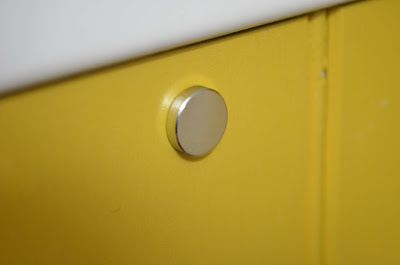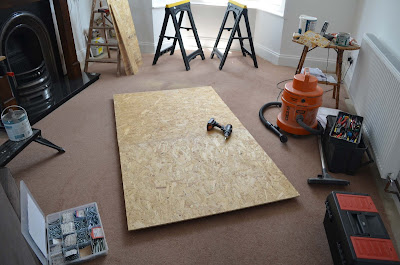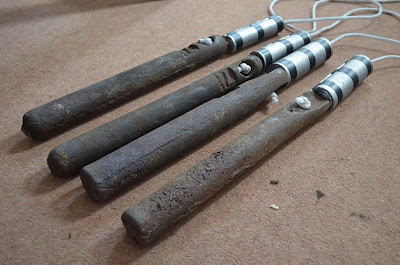The brass-ware on the front door and gate was looking rather tired, so Jacqui has been busy giving it a good clean up. "Mr Fox", the door knocker, has taken a lot of cleaning with Brasso, silver polish, T-cut, Astonish to name but a few!
And the door number has responded well to a bit of Brasso and some elbow grease.
Whilst there are still a number of jobs to do before completion, we've already started to work through some of the tasks on the snagging list. The timber fireplace surround had some worn areas where the original wood was starting to show through the woodstain so Jacqui has been treating it with Jacobean Dark Oak woodstain and a little acrylic paint to blend it with the surrounding surface.
In the bathroom, the removable bath panel was only temporarily secured with standard Quicksilver pozi screws so, having spotted some contemporary mirror screws in Wilkos at a mere £1.49 for 4, I decided to upgrade them...
...to these.
The window ledge had only ever had one topcoat so another couple of coats of white satinwood have been added using a sponge roller for a smooth finish.
And on the ceiling, the plaster had "popped" on several of the plasterboard screws so this had to be dug out and refilled with fresh plaster. Fine sandpaper was used to blend this back to the surrounding surface then, using several applications of diluted emulsion, I was able to cover these without leaving any evidence.
Work on the 'new' back door has continued this week. It has been primed, undercoated (twice) and topcoated with white gloss.
The repair to the rotten beading is almost invisible...
Concealed rack bolts have been sunk into the door top and bottom to provide extra security.
Before fitting the door, the frame needed some further attention. There were some subtle signs of rot through the paint so these areas were chiselled out, hardened with Ronseal wood hardener and then filled with 2 part filler.
The lock position on the new door is higher than the old one so a piece of scrap timber was trimmed to fit the old lock box rebate and glued in place using PVA.
The new rebate was then drilled and chiselled above the old one...
...and the old one covered with 2 part filler.
Now the old door could be removed and has since been disassembled ready for disposal.
And the new door has now been hung. Looking much smarter although there is still a bit more work required on the frame.


























































